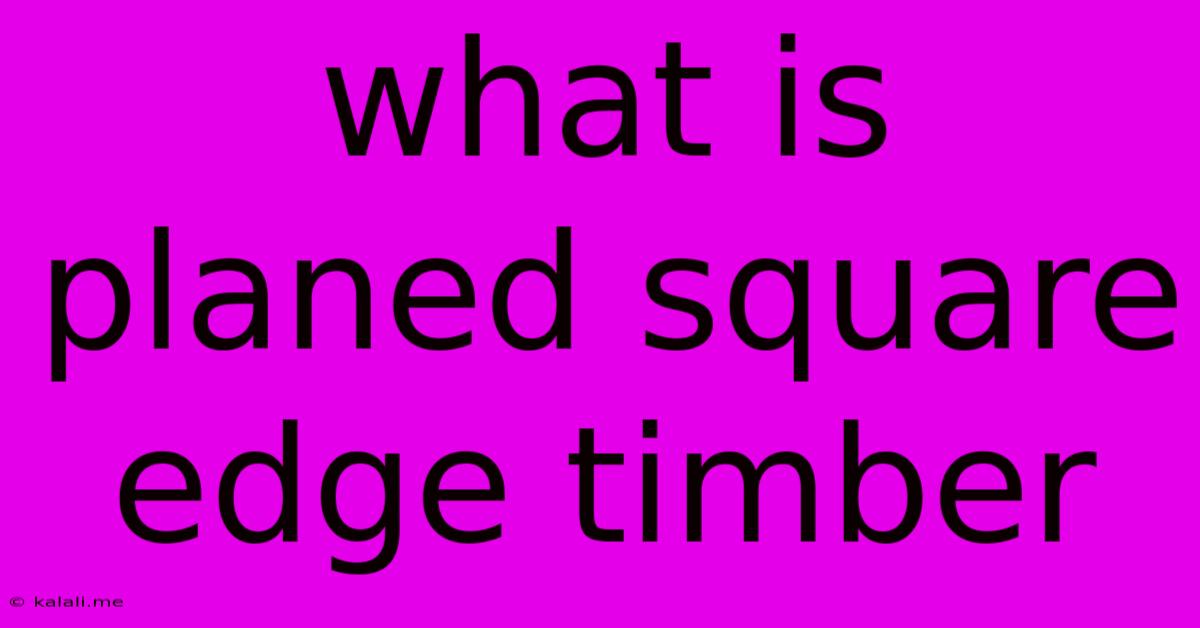What Is Planed Square Edge Timber
Kalali
May 21, 2025 · 4 min read

Table of Contents
What is Planed Square Edge Timber? A Comprehensive Guide
Meta Description: Discover everything about planed square edge timber: its definition, uses, advantages, disadvantages, and how it differs from other timber types. Learn to choose the right timber for your project.
Planed square edge timber is a type of timber that has been processed to have straight, smooth sides and a uniform square profile. This makes it a versatile and popular choice for a variety of construction and DIY projects. Unlike other timber types, understanding its specific characteristics is crucial for selecting the right material for your needs. This guide will delve into the details, explaining what makes planed square edge timber unique and when it's the ideal choice.
Understanding the Terminology
Let's break down the terms:
- Planed: This refers to the machining process where the timber is passed through a planer to create smooth, flat surfaces. This removes imperfections and ensures consistent dimensions.
- Square Edge: This indicates that all four sides of the timber are straight and at right angles to each other, unlike rounded or chamfered edges.
This combination—planed and square edge—results in timber that's easy to work with, offering precise dimensions for accurate construction.
Common Uses of Planed Square Edge Timber
The versatility of planed square edge timber makes it suitable for a wide range of applications, including:
- Framing and construction: It's ideal for building walls, roofs, and floors due to its strength and straight edges.
- DIY projects: From building shelves and furniture to creating garden structures, its ease of use makes it a favorite among DIY enthusiasts.
- Fence construction: The straight edges and consistent dimensions make it perfect for building strong and aesthetically pleasing fences.
- Decking (in some cases): While other treatments may be preferred for exterior decking, planed square edge timber can be used for substructures or less exposed areas.
- Moulding and trim: After further processing, it can be used for decorative mouldings and trims.
Advantages of Using Planed Square Edge Timber
Several benefits make planed square edge timber a popular choice:
- Ease of use: The smooth, straight edges simplify cutting, joining, and finishing processes.
- Accuracy: Consistent dimensions allow for precise construction and minimize waste.
- Cost-effectiveness: Compared to other types of timber with more elaborate processing, it's often a more budget-friendly option.
- Versatility: Its applications span a variety of projects, from large-scale construction to smaller DIY tasks.
- Strength: Depending on the species of wood, it can offer significant structural strength.
Disadvantages of Planed Square Edge Timber
While offering numerous advantages, it's important to acknowledge potential drawbacks:
- Appearance: The lack of character in the unmilled edges can be a drawback for projects where visual appeal is paramount. Some may find it less aesthetically pleasing compared to timber with naturally rounded edges.
- Knots and imperfections: While planing removes surface imperfections, knots and other natural imperfections within the wood might still be present, affecting its strength in some instances.
- Susceptibility to warping: Depending on the species and its treatment, it may be more susceptible to warping and twisting than other types of processed timber.
Planed Square Edge Timber vs. Other Timber Types
It's crucial to understand how planed square edge timber differs from other types:
- Planed All-Round (PAR) timber: This type of timber is planed on all four sides, but unlike square edge, it also has rounded or chamfered edges. It is typically more aesthetically pleasing.
- Rough sawn timber: This is untreated timber that retains its natural, rough-sawn surface. It requires significantly more preparation before use.
Choosing the correct type depends heavily on the project's specific requirements, budget, and aesthetic preferences.
Choosing the Right Planed Square Edge Timber
Consider these factors when selecting planed square edge timber:
- Wood species: Different species offer varying levels of strength, durability, and resistance to decay. Common choices include softwoods like pine and hardwoods like oak.
- Grade: Timber grades indicate the quality and consistency of the wood. Higher grades generally have fewer knots and imperfections.
- Dimensions: Select the appropriate dimensions to meet your project's requirements.
- Treatment: Consider whether you need treated timber for outdoor applications to enhance its resistance to rot and insect infestation.
By understanding the properties and characteristics of planed square edge timber, you can make informed decisions and ensure successful completion of your projects. Remember to always prioritize safety and follow best practices when working with timber.
Latest Posts
Latest Posts
-
What Size Wire For 100 Amp Service
May 23, 2025
-
How Long Does A Metal Roof Last
May 23, 2025
-
White Wine Vinegar Vs White Vinegar
May 23, 2025
-
3 In 1 Out Diamond Head 3d Printer Firmware
May 23, 2025
-
How To Get The Smell Of Gas Off Your Hands
May 23, 2025
Related Post
Thank you for visiting our website which covers about What Is Planed Square Edge Timber . We hope the information provided has been useful to you. Feel free to contact us if you have any questions or need further assistance. See you next time and don't miss to bookmark.